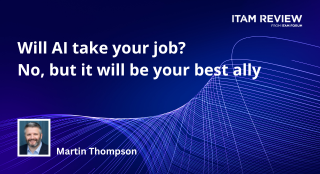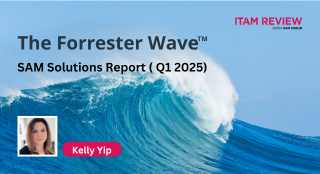Apptria Technologies - IAITAM Conference Preview & The Story Behind The Spin-Off
![]() SAM industry veteran Express Metrix have recently spun-off Apptria, a company specifically focused at providing software recognition capabilities to other ISV’s.
SAM industry veteran Express Metrix have recently spun-off Apptria, a company specifically focused at providing software recognition capabilities to other ISV’s.
Kris Barker, co-founder and CEO of Apptria will be presenting a session at the IAITAM Annual Conference and Exhibition this year entitled “The Software Identification Challenge”.
I recently corresponded with Kris regarding this new venture and a preview of his upcoming session at the conference.
Q. Why a spin-off? Why not continue under the Express Metrix Brand?
Apptria’s target customer, value proposition and offering are notably different from Express Metrix’s, and we felt that establishing a new business division that’s exclusively focused on the needs of ISVs will enable us to:
- Raise the visibility of the software recognition problem in the marketplace
- Provide a platform upon which to build brand recognition and articulate a distinct value proposition (while not diluting Express Metrix’s)
- Bring awareness to our solution outside the boundaries of traditional ITAM such as desktop management, service desk, security, and so on
It’s also important to point out that we have structured ourselves internally to support this new focus. Whereas previously, enhancements to the catalog were driven primarily by Express Software Manager’s requirements, there’s a more distinct line between these two areas of business that promotes independence of product direction and overall business strategy, as well as ensure the goals and needs of our respective customers bases are being met.
All that said, we believe very strongly that Express Metrix’ long history of developing the software catalog and associated domain expertise is key to Apptria’s story and its ability to deliver not only strong technology, but also ensure our partners’ success with their implementations.
Q. How has Apptria been received in the market?
I’m happy to say that the response has far exceeded our expectations. It’s testimony to the pain and frustration ISVs are experiencing with the process of software recognition, and its negative impacts upon their end user customers. The bottom line is that if your customers can’t trust the software data that serves as a foundation for critical IT processes, they won’t be successful with your product. And this costs you money as a solution provider in terms of lost business, increased support costs, and distraction from your core competencies and strategic priorities.
One thing that’s surprised us is the interest coming from ISVs outside the ITAM field. For example, we’re talking with a security solution provider with a wide range of related products that plans to use the catalog to evaluate what’s installed on their customers’ machines so they can recommend additional or alternative software that’s relevant to their situations.
Q. Can you share any plans for improving or expanding the catalogue?
I’m afraid I can’t get too specific about future enhancements, but the following are on the table:
- Integration of ISO 19770 into the offering
- Additional content (i.e. product use rights, licensable or not, etc.)
- Normalization of inventory feeds from other systems (i.e. SCCM)
- Developing related technologies that enable partners make the best use of the catalog data
- Implementation services
Q. For your session at the IAITAM Conference and Exhibition – you emphasize the importance of accuracy during an evaluation of software recognition technologies – can you provide any tips for organizations looking to complete an evaluation of SAM tools in terms of software recognition?
There are a number of areas I’d recommend organizations consider during an evaluation process:
a) Is the software recognition “license-centric”?
If management of software licenses is a key goal, it is critical to explore not just what a SAM product recognizes, but also how the tool recognizes, interprets, and classifies the information it “discovers”. Specifically, a SAM tool needs to discover all installed applications and identify them in such a way that lists of recognized applications can be easily aligned with entitlement requirements. This is easier said than done!
Here are some things to be particularly cautious about:
- Tools that identify each executable as an independent application. Most licensable apps are comprised of multiple, if not hundreds, of executables, leading to the burdensome manual task of determining which licensable applications each of those executables are associated with.
- Tools that only examine an installed programs list (such as Add/Remove Programs). There two major issues with this method. First, applications not installed using standard Windows installation services may not be discovered. Second, entries in this list are based on how a product is packaged for installation, which often results in entries that don’t correspond to how applications are actually licensed.
- Tools that don’t properly take versioning into account. This speaks to how data is organized and presented; specifically, the SAM tool should provide the ability to group multiple versions of an application to best represent how the application is actually licensed.
b) Can it accurately identify “complex” applications such as editions and suites?
Proper identification often requires more than simply knowing what the presence of a particular executable or registry entry means. Without additional information, it’s not possible to determine which edition of an application or suite is installed, a key aspect for understanding licensing. Here are some specific areas to explore:
- How does the tool distinguish between applications that share a common executable? Applications that are sold as part of multiple editions (such as the Standard and Professional versions of Adobe Acrobat) typically share a common executable, so executable analysis alone isn’t sufficient In these cases, additional information (such as that found in the registry) is required to determine the exact edition installed and, therefore, what entitlement is required for compliance.
- How does the tool identify suites and their constituent components? Suites such as Microsoft Office add even more complexity to the recognition process. It’s not sufficient to simply identify which components are installed, as this won’t reveal one’s entitlement requirement. And looking only at Add/Remove Programs entries may not yield the key component-level installation or usage data required to facilitate optimal license management. A hybrid approach to recognition based on file executable and additional information is required to properly identify such suites.
d) How broad is the application coverage, and does it cover titles relevant to your organization?
Many SAM solutions today base their recognition, at least in part, upon a signature catalog of some sort. For this reason, it’s important to find out how frequently the catalog and/or its recognition capabilities are updated. Additionally, given the variety of software upgrade policies used across companies, it’s important to evaluate recognition coverage from an historical standpoint. Actively maintaining a large software catalog is a specialized area that requires a great deal of commitment and expertise, and it’s an area SAM providers often sacrifice in favor of other features that may look great on a spec sheet but a lesser impact in terms of SAM effectiveness.
e) What is the process for handling unrecognized applications?
It’s important to realize that no SAM tool can be 100% complete. This means that at least some applications (home-grown as well as commercial) will not be automatically recognized. Any SAM tool should provide a way to account for custom and/or unrecognized applications so they can be managed along with recognized apps in a unified manner.
Q. You also mention in your session the adoption of ISO/IEC 19770-2 – Is Apptria / Express not well placed to take advantage of tagging and generate retrospective tags for older applications as part of your agent install?
We do indeed have plans for incorporating tagging into our solutions, but we’re not ready to share the specifics at this time. We’ll keep you posted!
Kris Barker’s session “The Software Identification Challenge” is on the Friday 14th October during the IAITAM Conference and Exhibition.
Can’t find what you’re looking for?
More from ITAM News & Analysis
-
AI Is Here—And It’s Your Best ITAM Ally, Not Your Replacement
I’ve been asked several times over the last couple of years how AI will impact ITAM and how it will impact jobs. Well, who knows what will actually happen in the future, but my guestimate is ... -
FinOps for SaaS: A Step in the Right Direction, But Will It Work?
The FinOps Foundation is making a bold attempt to get better visibility and control of SaaS applications. This has been driven in part because the vast majority of FinOps teams also manage SaaS to some extent. ... -
The Forrester Wave SAM Solutions Report (Q1 2025)
Forrester, the US based research firm, recently released its latest SAM Solutions Wave report for Q1 2025. The report reflects its research and analysis of nine SAM providers it considers to matter the most, and scores ...
Podcast
ITAM training
Similar Posts
-
AI Is Here—And It’s Your Best ITAM Ally, Not Your Replacement
I’ve been asked several times over the last couple of years how AI will impact ITAM and how it will impact jobs. Well, who knows what will actually happen in the future, but my guestimate is ... -
FinOps for SaaS: A Step in the Right Direction, But Will It Work?
The FinOps Foundation is making a bold attempt to get better visibility and control of SaaS applications. This has been driven in part because the vast majority of FinOps teams also manage SaaS to some extent. ... -
The Forrester Wave SAM Solutions Report (Q1 2025)
Forrester, the US based research firm, recently released its latest SAM Solutions Wave report for Q1 2025. The report reflects its research and analysis of nine SAM providers it considers to matter the most, and scores ... -
Will 'Sustainable IT' be Caught in the Crossfire?
In the days immediately following his inauguration, President Trump and his team declared war on Diversity, Equity, and Inclusion (DEI) programs at the federal level. The impact has been felt far and wide. Many government contractors ...




